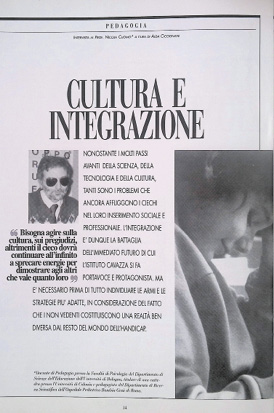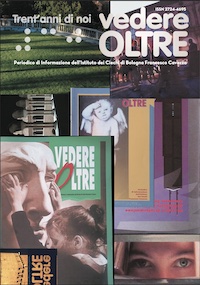 For thirty years, the Cavazza Institute in Bologna has been publishing “Vedere Oltre,” a magazine that describes and disseminates the experiences, innovations, and services that the Institute has gradually developed over three decades to serve the blind and visually impaired in Italy and abroad. In 1994, when I presented the new publication in my role as Chairman of the Institute’s Board of Directors, I was supported by over a century of guidelines and by the determination to continue to serve the blind and visually impaired, updating our actions and developing new studies regarding society, which was (and still is) rapidly transforming and imposed new conditions in which to identify strategies to ensure that the blind and visually impaired would have the best opportunities for empowerment and inclusion. Now, thirty years after our first issue, I remember, with warmth and infinite respect, everyone whose contributions, ideas, and fundamental contents made it an effective tool of information and discussion on the essential topics of academic, work-place, and social inclusion of the blind and visually impaired. My thanks first of all to our two editors-in-chief: Gian Carlo Roversi and Paola Rubbi, whose expertise and commitment guaranteed the growth and high quality of every issue. And to our friends and collaborators Enzo Tioli, Rodolfo Cattani, Ernesto Dini, Antonio Quatraro, and Andrea Canevaro, whose knowledge, experience, and enthusiasm helped develop viewpoints and discussions that allowed our magazine to play an active role in the national and international debate on the emancipation of disabilities. But how has the Cavazza Institute changed over these thirty years, and how has it adapted it activities to the new needs of the blind and visually impaired?
For thirty years, the Cavazza Institute in Bologna has been publishing “Vedere Oltre,” a magazine that describes and disseminates the experiences, innovations, and services that the Institute has gradually developed over three decades to serve the blind and visually impaired in Italy and abroad. In 1994, when I presented the new publication in my role as Chairman of the Institute’s Board of Directors, I was supported by over a century of guidelines and by the determination to continue to serve the blind and visually impaired, updating our actions and developing new studies regarding society, which was (and still is) rapidly transforming and imposed new conditions in which to identify strategies to ensure that the blind and visually impaired would have the best opportunities for empowerment and inclusion. Now, thirty years after our first issue, I remember, with warmth and infinite respect, everyone whose contributions, ideas, and fundamental contents made it an effective tool of information and discussion on the essential topics of academic, work-place, and social inclusion of the blind and visually impaired. My thanks first of all to our two editors-in-chief: Gian Carlo Roversi and Paola Rubbi, whose expertise and commitment guaranteed the growth and high quality of every issue. And to our friends and collaborators Enzo Tioli, Rodolfo Cattani, Ernesto Dini, Antonio Quatraro, and Andrea Canevaro, whose knowledge, experience, and enthusiasm helped develop viewpoints and discussions that allowed our magazine to play an active role in the national and international debate on the emancipation of disabilities. But how has the Cavazza Institute changed over these thirty years, and how has it adapted it activities to the new needs of the blind and visually impaired?
In 1994, the first year of "Vedere Oltre," while we finally managed to restore the Institute’s economic balance sheet, we also continued to train telephone operators. With appropriate updates of the program, this is still an important part of our activities, and every year it provides 25-30 blind or visually impaired people with valid professional training that lets them find adequate work opportunities. In 1998, the Institute inaugurated the Anteros Tactile Museum of Ancient and Modern Art, which, with its collection of bas relief reproductions of great paintings, has allowed many blind and visually impaired people to take an important training course in the fields of painting and art history. Toward the end of the last century, following Law 284/97, the Institute recognized the need to establish a vision rehabilitation service, and therefore opened the low vision center. With many local and national initiatives, the center has tried to meet the many needs of the visually impaired and of people who (perhaps in old age) find that they have to live with significant vision problems. In 1999, in collaboration with the Federazione Nazionale delle Istituzioni Pro Ciechi, the Institute launched the C.I.S.A.D. informatics center for the study and assessment of teaching aids, continuing its long-standing collaboration with the regional center for the production of teaching aids and materials. Based on its previous activities, the Institute also further expanded its research in the IT sector, developing hardware and software to promote accessibility to informatics and new technologies by the blind and visually impaired. The activity, conducted by Cavazza since the mid-1980s, has expanded and developed, becoming a national and international reference point, and was a main partner of INVAT (Istituto Nazionale per la Valutazione Ausili e Tecnologie), created in 2018 by Unione Italiana dei Ciechi e degli Ipovedenti.
 Based on previous experience, at the start of the 21st century the Institute launched its Educational Consulting Service, which strengthened and developed inclusive education support services for blind and visually impaired children and teens. It offers consulting and tiflo-didactic and tiflo-psychological information to families, schools and professionals in the academic, healthcare, and social fields, with the contribution of professor Enzo Bizzi and the commitment of numerous professionals working at this Center. Every year, it supports hundreds of blind and visually impaired children and teens, their families, the schools they attend, and their teachers and assistants in our regional school system. In 2006, the Institute launched an important communication and information initiative to accompany our magazine: "Radio Oltre," the Institute’s web radio, offers a variety of programs regarding visual disability and disability in general, providing an opportunity to consider topics of concern to everyone. In 2015, the Institute opened the Tolomeo Museum, presenting the Institute’s history and the innovations developed in over 130 years of its existence in relation to Bologna and the local area. This new project was expanded with an atelier in which blind and visually impaired children and teens can experiment with possibilities, occasions, and tactile experiences in a wide variety of environments and situations. In recent years, the Institute has conducted training activities in every area and sector of its operations, providing training to the blind and visually impaired, to their families, and to professionals involved at various levels in the education and training of people with visual disabilities. These programs have involved people in the healthcare, social services, and cultural sectors, and in many other spheres, who have dealt with the issue of accessibility and full participation of people with visual disabilities. Moreover, with the technological and computer skills that our Institute has developed over the years, we were able to stay in contact (even during the long months of lockdown) with children, teens, and adults with serious visual difficulties, maintaining relationships to make less dramatic the isolation created by the pandemic. The Cavazza Institute now faces a tough road ahead, based on the services already offered, but with the awareness of a new challenge to be faced in the near future: our Institute must be able to provide sufficient and effective answers to the needs of people with complex disabilities. Unfortunately, the number of these people has constantly increased and, although we are aware of being neophytes in this sector, it is still essential to start working on ideas, plans, proposals, and actions that will provide relief, solutions, and opportunities to people in critical situations caused by the emergence of multiple disabilities in a single person. This topic will be of growing concern to our Institute and therefore to this magazine, which must be able to involve people and institutions with years of experience and expertise, so that they may make significant contributions to a thorough understanding of the problem and to the creation of important, innovative, and high-quality services and actions in our area. This will be the main challenge for our Institute and our magazine in the future. I am certain that with the commitment, expertise, knowledge, and passion of all of our managers, employees, and collaborators at every level, we will face this daunting challenge and identify the strategies, resources, and services needed to provide an effective response to our Region and to people with complex disabilities.
Based on previous experience, at the start of the 21st century the Institute launched its Educational Consulting Service, which strengthened and developed inclusive education support services for blind and visually impaired children and teens. It offers consulting and tiflo-didactic and tiflo-psychological information to families, schools and professionals in the academic, healthcare, and social fields, with the contribution of professor Enzo Bizzi and the commitment of numerous professionals working at this Center. Every year, it supports hundreds of blind and visually impaired children and teens, their families, the schools they attend, and their teachers and assistants in our regional school system. In 2006, the Institute launched an important communication and information initiative to accompany our magazine: "Radio Oltre," the Institute’s web radio, offers a variety of programs regarding visual disability and disability in general, providing an opportunity to consider topics of concern to everyone. In 2015, the Institute opened the Tolomeo Museum, presenting the Institute’s history and the innovations developed in over 130 years of its existence in relation to Bologna and the local area. This new project was expanded with an atelier in which blind and visually impaired children and teens can experiment with possibilities, occasions, and tactile experiences in a wide variety of environments and situations. In recent years, the Institute has conducted training activities in every area and sector of its operations, providing training to the blind and visually impaired, to their families, and to professionals involved at various levels in the education and training of people with visual disabilities. These programs have involved people in the healthcare, social services, and cultural sectors, and in many other spheres, who have dealt with the issue of accessibility and full participation of people with visual disabilities. Moreover, with the technological and computer skills that our Institute has developed over the years, we were able to stay in contact (even during the long months of lockdown) with children, teens, and adults with serious visual difficulties, maintaining relationships to make less dramatic the isolation created by the pandemic. The Cavazza Institute now faces a tough road ahead, based on the services already offered, but with the awareness of a new challenge to be faced in the near future: our Institute must be able to provide sufficient and effective answers to the needs of people with complex disabilities. Unfortunately, the number of these people has constantly increased and, although we are aware of being neophytes in this sector, it is still essential to start working on ideas, plans, proposals, and actions that will provide relief, solutions, and opportunities to people in critical situations caused by the emergence of multiple disabilities in a single person. This topic will be of growing concern to our Institute and therefore to this magazine, which must be able to involve people and institutions with years of experience and expertise, so that they may make significant contributions to a thorough understanding of the problem and to the creation of important, innovative, and high-quality services and actions in our area. This will be the main challenge for our Institute and our magazine in the future. I am certain that with the commitment, expertise, knowledge, and passion of all of our managers, employees, and collaborators at every level, we will face this daunting challenge and identify the strategies, resources, and services needed to provide an effective response to our Region and to people with complex disabilities.





.png)